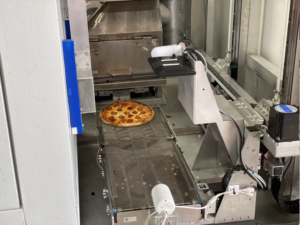Special to the L.A. Weekly.
I had been living in Hollywood for about a year in 1977. I drove a ’63 Impala, was recently married, on the Slash magazine masthead and art director for Greg Shaw’s Bomp Records. My new wife and I lived in a low rent slightly beat up arts and crafts mansion on the edge of Hancock Park sharing the $250 monthly with John Doe and Exene Cervenka and another Brit Jonh Ingham and his girlfriend Sheena. Top Jimmy crashed on a sofa on the shady front porch. Jonh had written the first ever article on the Sex Pistols for the NME and had managed Billy Idol, we’d both seen the Sex Pistols first gig in 1975 which was shambolic but memorable. Out back there was an old A-frame garage where the proto “X” and bands like Wall of Voodoo rehearsed. X had played their first gig in the mansion’s large paneled living room.
The Masque nightclub had recently opened, giving the new scene an actual venue for bands to play and foment — serving the same function as CBGB’s in New York or the Roxy in London. I had recently designed a flyer for the young Scottish club owner that used a photo of Scene It Girl Trudie. At the club one night I was approached by a guy I’d seen around but not spoken to.
“You designed that flyer with Trudie on it?”
“Yeah.”
“I have a project and I need a designer.”
This was Jules and we got talking as the music crashed around us.
The project in question was an LP cover for pop star Nick Gilder, you might have heard his hit “Hot Child in the City.” Together we explored the nighttime wastelands of empty downtown L.A. parking structures and came up with a fitting location. But before this happened Jules had something to share.
“You’re going on a date with him,” my wife insisted.
“He wants to show me a movie.”
“It’s a date.” She was right.
A double feature, noir.
First a grimy John Garfield flick but the main feature was what Jules wanted me to see. William Golding’s Nightmare Alley. Without overthinking it, moving to Hollywood from the UK in 1976 was a fulfilment of an art school fetish for 1940’s style. Noir movies, U.S. and Japanese, figured into my design sensibilities. Jules and I clicked. Over time he shared The Lady from Shanghai and Brassaï with me, and I shared El Lissitzky and Malevich with him. Rod Serling, Kurosawa, Wyndham Lewis. Visually and intellectually we had a lot in common and this led to an instinctual rapport. Jules thought we should form as a group, like Hipgnosis. I came up with Artrouble — Got an art problem? Call Artrouble. Jules laughed out loud and it stuck. We even registered it.
The U.S./U.K. media had already pigeonholed the new ‘punk’ scene and their approach was strictly safety pins, leather and spit. We were out to change that. Most L.A. punks dressed retro in some way which, compared to the flared denim and double-knit preferred by 70’s SoCal hipsters, looked totally futuristic and inspired what became new wave in the 1980’s.
Our first LP cover as Artrouble was for the Dickies, the first Masque band to sign to a ‘major’ label, in this case A&M on La Brea, across from the Top Taco stand where Top Jimmy served top tacos to punks and tourists taking in Charlie Chaplin’s old studio across the street. Jules had already shot an EP 10” cover for the Dickies that fit the grainy Ramones/Deadboys aesthetic for ‘signed’ punk bands. Jules had been at the same high school as these kids, they were buddies and shared a North Hollywood perspective on the town over the hill. So we weren’t going to deliver exactly what the label expected, we were going to give them what we and the band wanted. That LP was The Incredible Shrinking Dickies and for the band the rest is history. The LP became huge far beyond the US and the band is still a vital and productive source of amusement and true punk rock spirit. The Dickies were also blessed with having Jeffrey Ayeroff overseeing their ‘birth’ and Jeff was also generous with Artrouble before going on to form Virgin Records, discover Prince and sign Madonna. He offered me a job but I turned it down for Artrouble.
Our studio was a high-ceilinged storefront in a Spanish styled building on 6th Street near Alexandria close to the Ambassador Hotel and a big Brown Derby hat. It had a huge glass window that Mohamed Ali glided past in a Rolls one day, and equally large blinds. Jules never used a seamless preferring to paint new sets as needed. About 3/4 of the way back the studio was split into two levels with a balcony level that looked down onto the photo area. Up there was my studio; a long table and a couple of beyond interesting 1950’s chairs and the space could double for changing, like the time Jules shot Earth Wind and Fire. Back downstairs a make-up station for Phyllis, a bathroom and Jules’ darkroom. Jules had a small black and white TV with a red gel over the screen in there, it was always on. Lunchtimes we’d watch back to back episodes of the Twilight Zone together, but also Bob Newhart, Jules’ favourite comedian and an education to me.
Other projects followed and Jules was asked to photo edit the nascent L.A. Weekly. He was given dream assignments for any photographer let alone an ArtCenter dropout from the Valley. David Lynch, Harry Dean Stanton, Charles Bukowski and many more. I hope that rag has kept some copies for posterity. Harry Dean arrived early and was peckish. We directed him to a taco stand on the corner. When he came back I noticed he had taco sauce on his chin and pointed it out to Jules. “Leave it, don’t tell him.” It was part of the Artrouble aesthetic.
We completed a project for the bombastic Kim Fowley, Snake Document Masquerade, just one of many mildly eccentric LP’s he put out that year. Punk was taking a toll on the maestro of Sunset Strip sleaze.
Jules and I had decided to pick up the check from the Island Records office on Sunset, cash it and set off for San Francisco via Route 1 in his Ford Capri. On acid.
Jules drove the whole way, the car was a stick so beyond my abilities while flying. We had our portfolios in the trunk in case they dropped the Big One on L.A. and we hit the Pacific coast. I won’t bore you with an acid trip story or describe what the artichoke capital of the world or the Hearst Castle looked like with vastness of the ocean to our left and a narrow empty band of highway ahead. I will say that as night fell and a sea fog shrouded the brown Capri I felt a great dread, death seemed very close somehow, I said nothing and Jules kept driving. We plunged into a forest of giant trees, the mist thinned and a great white city emerged. The Gloom lifted.
“Why do you think it’s all lit up like that?” he asked me.
“Because it looks cool?” It was radiant.
“It’s the banks, it’s a 24 hour city trading with banks on the other side of the world.”
We were coming down by now and checked into an old hotel in a dingy deserted part of town, the U.S. Mint was across the street. We had some entertainment possibilities, our buddies the Weirdos were in town but so were the then unknown Go-Go’s and it turned out we had checked into the same hotel as the girls. We had no choice, they were in our suite bouncing on our beds. We saw the Go-Go’s.
A few days later on the return trip we decided to forgo the coast road, and Charlotte from the band was along for the ride back to L.A. Somewhere in that long valley the Capri died in a cow town. Jules found a phone called a garage, they came and he sold the car and we caught a Greyhound with our Go-Go pal. Back in L.A. he quickly replaced the Capri with a Nash Metropolitan. Did I mention Jules was a gearhead?
Perhaps not quite next was DEVO, who I had met in part through Slash magazine. I’d done some layout work for them for a 45 on Bomp and we had mutuals. Mark and Gerry were interested in Artrouble for their next and possibly last LP for Warner Bros. I met them alone over sushi, Jules wanted me to handle it. The album Freedom of Choice has a 33⅓ book dedicated to it and a chapter about the involvement of Artrouble so I won’t go into detail. But DEVO were facing low interest and sales and a label that still hitched its star to longhair cock rock, overwrought pop and disco. DEVO packaging was goofy, arty but not serious. Artrouble took new music seriously, so did DEVO so we did a serious record with flags and hats and plastic suits. N.B. Artrouble did not design the energy domes!!! That album transformed their career and its trajectory, transforming them into a group that still has a devoted cult following around the world. It is these people that informed me of the transformational effect the record cover had in a time before MTV or the Internet. In any event DEVO used some of our outtakes without asking or paying, images that have been used over and over since but even then Jules was angry, and what should have been a mutual triumph for us and the band ended sourly.
All this while Jules was getting more fashion work which involved Phyllis Cohen more than me, but that added to my experience as an art director in the future. Many stylists and models were happy to work gratis as they knew their work shot by Artrouble would jump out of their portfolios. In turn, Jules’ unique style was being seen by more people. One day we went to visit Matthew Rolston who had a studio on Highland and wasn’t very famous at all at that time. I think they’d been at ArtCenter together. Matthew was falling over himself gushing praise. It seemed funny at the time and then a short while after Jules died when I was living in New York, Rolston became the most famous photographer in the world and it didn’t seem funny anymore.
One LP project called for Jules’ photos, my logo but not Artrouble’s design aesthetic, and we were hired and paid separately. Jules’ band photos were terrific, my logo was used on subsequent albums, but the front cover with an airbrushed Lamborghini mashup with the band by the label’s own art department was too much for Jules who refused to allow a photo credit for himself. And while I did get a re-use payment for the logo Jules’ fee for the photos shot on a rented set with the rented Lambo was much higher and when these kinds of situations cropped up or I was left out it undermined Artrouble financially. In another situation the Manhattan Transfer were interested in us. They were staying in the Hollywood Hills rehearsing their new album and invited us over for a pitch. We showed them our work, in particular some of Phyllis’ amazing fashion drawings and makeup studies. They sat around a grand piano and they serenaded us with their hits. It was frikken heaven and they were really nice and seemed interested. After we’d pitched and headed back to the studio Jules said we’d need an advance which was true, we usually had no problems with A&M. But no deal. They passed on us and that album got a Grammy with a cover that looked a lot like Artrouble might have done it.
Like the scene we were part of, changes were happening fast. Everyone was going through it, my marriage didn’t survive nor Jules’ relationship with Phyllis. But before Artrouble split we’d decided to make a collaborative piece, a poster, that we hoped would get us known as a collective instead of the satellites we were becoming. The Artrouble poster is a large nine color silkscreen made for us by our amigo Richard Duardo q.e.p.d. of Modern Multiples fame. Four color registration is required for the photo, meaning it drove Richard crazy and then he had five more colors to deal with in a time long before computers handled this job. What we created is I hope timeless, Afrofuturism perhaps but a statement about bold choices made when that wasn’t popular.
We were too young to understand the uniqueness of our situation; Jules was impatient and made some bad choices vis-a-vis Phyllis and myself but he was doing fine and I wanted to leave for New York anyway, and Phyllis did well beyond our wildest aspirations moving to the U.K. One of the reasons we put Artrouble together was to work with Bowie and Phyllis did that, creating the shadow makeup for Blue Jean and having him sing ditties to her. But I did have my Iggy Pop LP cover and Jules his Eno photo.
Our punk scene had become hardcore, violent and riddled with heroin, liquor and dumbness. Some of the original Masquers were getting famous to the chagrin of their peers. The Masque itself was gone, Slash was selling out. People were moving, some were dying. In the fall of 1980 I drove a ‘63 Galaxie to New York. A while later I was art director at the East Village Eye and the new thing was late night bowling at the Bowlmor on University Place near NYU. It’s the last place I saw Jules. I went over. We spoke for a bit, catching up, he was in town to shoot furniture, some video involved, a new interest. A few weeks later a mutual friend called to tell me Jules had died and how.
I wrote an obituary for him in the East Village Eye and broke up with my girlfriend. I understand from our friends Jules was exhibiting an erratic side of himself and at times did some questionable stuff. He did have a dark sense of humor. Because of him I’ll never ride on a motorcycle again but he loved machines and was a free-spirited man. If his imagination had led him to film via video and he were with us today I expect we would have a famous auteur donating a scholarship or a new wing to ArtCenter. For a while he was my best friend and what we had was important to us. We lived in a material world chasing after immaterial things.
Jules Bates is a strong presence in the hearts of his friends and family and will be forever missed but I want people to see what a visionary he was and how he affected photography and the world he lived in.
The post ARTROUBLE: Julius Xavier Bates appeared first on LA Weekly.







0 Commentaires